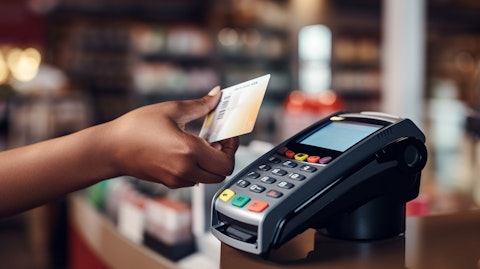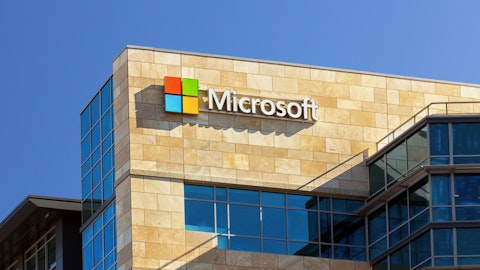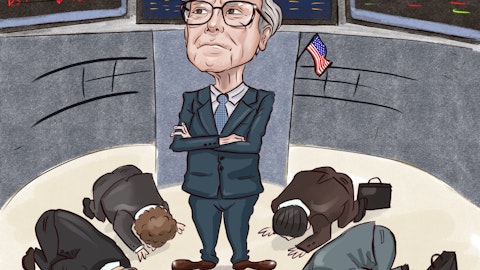Mastercard Incorporated (NYSE:MA) Q4 2023 Earnings Call Transcript January 31, 2024
Mastercard Incorporated beats earnings expectations. Reported EPS is $3.18, expectations were $3.08. MA isn’t one of the 30 most popular stocks among hedge funds at the end of the third quarter (see the details here).
Operator: Good morning. My name is Briana, and I will be your conference operator today. At this time, I would like to welcome everyone to the Mastercard Incorporated Q4 and Full Year 2023 Earnings Conference Call. [Operator Instructions]. Mr. Devin Corr, Head of Investor Relations, you may begin your conference.
Devin Corr: Thank you, Briana. Good morning, everyone, and thank you for joining us for our fourth quarter 2023 earnings call. With me today are Michael Miebach, our Chief Executive Officer; and Sachin Mehra, our Chief Financial Officer. Following comments from Michael and Sachin, the operator will announce your opportunity to get into the queue for the Q&A session. It is only then, that the queue will open for questions. You can access our earnings release, supplemental performance data and the slide deck that accompany this call in the Investor Relations section of our website, mastercard.com. Additionally, the release was furnished with the SEC earlier this morning. Our comments today regarding our financial results will be on a non-GAAP currency-neutral basis unless otherwise noted.
Both the release and the slide deck include reconciliations of non- GAAP measures to GAAP reported amounts. Finally, as set forth in more detail in our earnings release, I’d like to remind everyone that today’s call will include forward-looking statements regarding Mastercard’s future performance. Actual performance could differ materially from these forward-looking statements. Information about the factors that could affect future performance are summarized at the end of our earnings release and in our recent SEC filings. A replay of this call will be posted on our website for 30 days. With that, I will now turn the call over to our Chief Executive Officer, Michael Miebach.
Michael Miebach: Thank you, Devin. Good morning, everyone. Here’s the headline. We closed out 2023 with another quarter of strong earnings and revenue growth. Quarter four net revenues were up 11% and operating income up 13%, both versus a year ago on a non-GAAP currency-neutral basis, excluding special items as always. These results were driven by healthy consumer spending and the ongoing execution of our strategy. Our deal momentum continued this quarter, powered by a broad range of unique diversified products and services both designed to solve our customers’ needs. Let’s start on the macroeconomic front, where we see both tailwinds and headwinds. First, the labor market remains strong with low unemployment and rising wages.
These remain key drivers of consumer spending. Some risks we’re monitoring include credit availability and delinquency rates. Second, while inflation continues to moderate, prices of many goods and services remain elevated. We’re tracking the efforts of central banks who are actively managing interest rates to normalize inflation. And finally, geopolitical uncertainty remains a concern in several markets. On balance, we remain fairly positive about the growth outlook, but we are monitoring the environment closely and we’ll manage the business accordingly. Looking at our switch trends this quarter, domestic volume growth remains healthy and cross-border spending remains strong, up 18% globally in the fourth quarter on a local currency basis.
With that as a backdrop, we remain focused on our strategic priorities which fuel our growth algorithm across payments and services and new networks. In payments, our growth algorithm consists of five key areas. One, being in the flow to capture the natural growth of economies. Two, accelerating the secular shift to electronic payments across both spend and transactions. Three, further penetrating the addressable market in new flow. And four, growing market share, and five, optimizing our customer portfolios for performance. Economies are growing and that’s not in our control. However, we are executing on the rest. Building on that, the runway for the secular shift is substantial. We are accelerating it by scaling acceptance, enhancing the user experience for digital transactions and driving adoption in new sectors and new use cases.
In 2023, we added millions of new acceptance locations worldwide. This growth has been aided by scaling our tap on phone and cloud commerce capabilities. We’re now live in over 18 markets. Smaller merchants can start accepting payments by simply downloading an app, and larger merchants are leveraging the technology to promote quick and seamless checkout experiences anywhere in store. We’re supporting partners like Apple, who in 2023 expanded tap to pay on iPhone into Australia, the UK, France, Brazil and several other markets. We’re also accelerating the secular shift away from both from cash and closed-loop transactions such as transit through our contactless capabilities. Contactless provides a fast, secure and seamless consumer experience in areas like transit, which creates an opportunity to capture incremental transactions with a tap for every single ride.
And when consumers use contactless for transit, they often extend that behavior across other low dollar spend categories. We’ve made great progress with many major cities such as London and New York, operating broad-based open-loop systems. However, there’s still significant runway for us given that only a small percentage of large cities globally are operating open-loop systems at scale. And we’re leaning into advanced payment technologies like Click to Pay, tokenization and biometrics. They offer embedded, secure and password-free checkout solutions and with that bring an elevated level of security, simplicity and speed to every transaction. And that’s true regardless of the device, browser, or card. These solutions not only benefit consumers, but they also create value for merchants as their customers are less likely to abandon a transaction and issuers also benefit from an increase in customer stickiness.
For Click to Pay, we are now live in over 35 countries supported by over 50 channel partners. And in 2023, we drove over 60% growth in transactions. Klarna will implement Click to Pay this year and activate their merchants across all European markets where they operate. We’re driving tokenization across all channels including devices, commerce platforms, card on file and guest checkout. Tokenization reduces fraud and increases approval rates by approximately 3 to 6 percentage points across regions. And we’re expanding our biometric payment capabilities, which enable payments with a smile or a wave. After launching in Brazil, we have now partnered with NEC Corporation to bring our biometric checkout to the Asia-Pacific region. We’re also driving growth by winning and retaining deals across consumer payments, account to account and new flows.
This week, we shared that BOK Financial will flip its U.S. Debit portfolio to Mastercard, making us the exclusive partner across its debit and commercial portfolios. They selected us due to our differentiated virtual card and open banking assets fraud solutions and our shared commitment to financial inclusion. This marks the third U.S. regulated debit flip we signed in the last year building on our recent successes with Citizens and Webster Bank, both of which have now started converting their portfolios. And BPER Banca, one of the largest banks in Italy, will migrate their debit card portfolio to Mastercard as well. We renewed our partnership with Commonwealth Bank of Australia where we will retain exclusivity across their consumer credit and debit portfolios.
We signed a long-term partnership with Shinhan Card, the largest issuer in Korea, to solidify our leadership in the country. This relationship spans consumer and commercial card offerings and expands into new services including data analytics. And in Canada, we executed an exclusive long-term renewal of the President’s Choice Financial, consumer credit and prepaid portfolios. We’re also winning in fintechs, co-brands and public sector partners. When it comes to fintechs, Mastercard is a partner of choice. In fact, Mastercard serves over 80% of the top digital payment and neobank fintechs on the CNBC Global Fintech list. This quarter, Starling Bank, one of the largest fintechs in the UK renewed their partnership with Mastercard. In the co-brand space, we’re partnering with J.
Crew and Synchrony in the U.S. to launch the retailer’s first co-branded digital first card. And in the public sector, we have an exclusive partnership with Fiserv Money Network for all U.S. state and federal government benefit and wage disbursement debit programs. As part of our partnership, we are thrilled to launch with the California Economic Development Department in February, the largest unemployment program in the United States. As you can see, we continue our positive deal momentum powered by our differentiated products and services, while always keeping a focus on financial discipline. This also helps us to capture more of the secular tailwind and in turn further drive services growth. Looking to China, we are thrilled that our joint venture in China has released formal approval to commence domestic bankcard clearing.
Believe that we will be uniquely positioned to provide Chinese consumers with an exceptional payment experience using a single card that’s optimized for both domestic and cross-border spend. While we’re excited about the medium to long-term opportunity, there’s still work to be done as we fully build out the issuing and acceptance footprint. As we do that, we continue to grow our presence with bank and fintech partners in the market. ICBC launched the first world Mastercard product in November and Bank of Communications selected Mastercard to launch their first international debit card. Beyond cards, we also continue to make meaningful progress in the account-to-account space. This quarter, we announced a long-term strategic partnership with The Clearing House, the operator of the RTP network, which continues to secure our position in real time payments in the United States.
Now shifting gears, we continue to execute against our strategy to capture the large secular opportunity in targeted new flows including commercial payments and disbursements and remittances. We continue to win in commercial. This spans commercial point of sale and B2B accounts payable which we target through our market-leading virtual card solution. This quarter alone we renewed our commercial relationships with JPMorgan and FLEETCOR, two of the largest commercial issuers in the United States. BNP Paribas Fortis will flip their business credit portfolio to Mastercard in Belgium and on the virtual card front, we announced two exciting partnerships in the online travel agency space with Booking.com and Agoda. Turning now to disbursements and remittances.
In 2023, we grew transactions by over 30%. We continue to scale our use cases. For example UBS has integrated our cross-border services capability. This will enable them to execute instant cross-border payments from multiple use cases, including helping their customers pay employees abroad. In addition, we also partnered with Alipay to establish them as a cross-border payments receiving institution in China. Payments, services and new networks reinforce each other. We said it countless times. Our services and new networks provide differentiation as noted in many of the wins I mentioned. Underlying payments growth helps drive services too and payments growth brings incremental rich data. Our services turn that data into valuable insights and when implemented by our customers, those insights can drive incremental digitization of payments.
In turn, this generates even more data, more transactions, more need for fraud tools and the powerful cycle continues. The services and new networks components of our growth algorithms are built on, driving increased penetration of existing customers, extending our services across new customers and customer types and continuing to build and deploy new services. Here are a few examples how we are executing against each of these. The past year Bank of America has expanded their services relationship with us to include test and learn program management and supplier enablement solutions. This is on top of many of our services they already have. Axis Bank in India has also expanded their relationship with us. They will use our consulting, marketing and analytics services to support end-to-end portfolio lifecycle management.

Worldpay is utilizing our fraud alerts to streamline the dispute resolution process. And Citi has deployed consumer clarity digital receipts to provide eligible U.S. cardholders with detailed purchase information directly to their bank app. Now with increased visibility about the merchant and purchase details, consumers can easily validate transactions and reduce the number of disputes they file. Square is also integrating consumer clarity solution. Furthermore, Nexi has chose Mastercard as a strategic partner to rollout open banking for e-commerce payments across Europe and the list goes on. We’re extending our services and solutions across new customer types including large marketplaces. Alibaba will use Mastercard’s open banking technology to help streamline the onboarding experience for small businesses on the U.S. marketplace and reduce fraud.
And Meta utilizes our digital identity technology to improve authentication for online orders. We also continue to develop new services and solutions, many of which leverage the work we are doing with Generative AI. Generative AI brings more opportunity to drive better experiences for our customers, and makes it easier to extract insights from our data. It can also help us increase internal productivity. We’re working on many GenAI use cases today to do just that. For example, we recently announced Shopping Muse. Shopping Muse uses Generative AI to offer a conversational shopping tool that recreates the in-store human experience online, can translate consumers’ colloquial language into tailored recommendations. Another example is Mastercard Small Business AI.
The tool will draw on our existing small business resources along with the content from a newly formed global media coalition to help business owners navigate a range of business challenges. The platform, which is scheduled for pilot launch later this year, will leverage AI to provide personalized real-time assistance delivered in a conversational tone. And finally, we expanded Mastercard Access, which provides customers with a single point of connectivity to quickly and easily source our AI digital and identity services. Using access customers can deploy these services across multiple rails or networks including those outside the Mastercard network. This is an exciting development, which enhances our ability to scale our services across networks and streamlines the ability for our customers to adopt our capabilities.
So with that, I will wrap it up. In summary, we delivered another strong quarter and year of revenue and earnings growth. We’re successfully executing against our strategy and on our growth algorithm. Our differentiated capabilities, diversified business model and focused strategy position us well to capitalize on the significant opportunity in front of us. Sachin, over to you.
Sachin Mehra: Thanks, Michael. Turning now to Page 3, which shows our financial performance for the fourth quarter on a currency-neutral basis, excluding where applicable, special items and the impact of gains and losses on our equity investments. Net revenue was up 11%, reflecting continued growth in our payment network and our value-added services and solutions. Operating expenses increased 9%, including a minimal impact from acquisitions. And operating income was up 13%, including a minimal impact from acquisitions. Net income and EPS increased by 15% and 18%, respectively, both reflecting the strong operating income growth as well as a non-recurring tax benefit recognized in the fourth quarter. EPS was $3.18, which includes an $0.08 contribution from share repurchases.
During the quarter, we repurchased $1.8 billion worth of stock and an additional $586 million through January 26, 2024. So let’s turn to Page 4, where you can see the operational metrics for the fourth quarter. Worldwide gross dollar volume or GDV increased by 10% year-over-year on a local currency basis. In the U.S., GDV increased by 4% with credit growth of 5% and debit growth of 3%. Outside of the U.S., volume increased 13% with credit growth of 13% and debit growth of 12%. Sequentially, the debit growth rate was primarily impacted by the lapping of the NatWest portfolio migration in the UK. Overall, cross-border volume increased 18% globally for the quarter on a local currency basis, reflecting continued strong growth in both travel and non-travel related cross-border spending.
While this is sequentially lower versus Q3, this is primarily due to tougher comps as we continue to lap the cross-border travel recovery from last year. Turning to Page 5. Switched transactions grew 12% year-over-year in Q4, both card-present and card-not-present growth rates remain strong. Card-present growth was aided in part by increases in contactless penetration as contactless now represents approximately 65% of all in-person switched purchase transactions. In addition, card growth was 8%. Globally, there are 3.3 billion Mastercard and Maestro-branded cards issued. Turning to Slide 6 for a look into our net revenues for the fourth quarter discussed on a currency-neutral basis. Payment Network net revenue increased 7%, primarily driven by domestic and cross-border transaction and volume growth and also includes growth in rebates and incentives.
Value-added Services & Solutions net revenue increased 17%, primarily driven by strong growth in our Cyber & Intelligence Solutions, driven by the growth in our underlying drivers and the continued scaling of our fraud and security solutions and our identity and authentication solutions. In addition, we saw strong growth in our marketing, data analytics and consulting services as well as our loyalty solutions. This was partially tempered by slower relative growth in our other solutions. Now let’s turn to Page 7 to discuss key metrics related to the payment network, again, described on a currency-neutral basis unless otherwise noted. Looking quickly at each metric. Domestic assessments were up 7%, while worldwide GDV grew 10%. The difference is primarily driven by mix.
Cross-border assessments increased 21%, while cross-border volumes increased 18%. The 3 ppt difference is primarily due to favorable mix. Transaction processing assessments were up 10%, while switched transactions grew 12%. The 2 ppt difference is primarily due to lower revenues related to FX volatility versus the prior year. Other network assessments were $251 million this quarter. As a reminder, these assessments primarily relate to licensing, implementation and other franchise fees and may fluctuate from period to period. Moving on to Page 8. You can see that on a non-GAAP currency-neutral basis, excluding special items, total adjusted operating expenses increased 9%, which includes a minimal impact from acquisitions. This increase was primarily due to increased spending on personnel to support the continued execution of our strategic initiatives and increased spending on marketing campaigns, advertising and sponsorships like the UEFA Champions League and the Rugby World Cup.
Turning to Page 9, you will see that we are no longer providing operating metrics as a percentage of 2019 given that we are well past the pandemic. Now let me comment on the operating metric trends in the fourth quarter and through the first four weeks of January. Starting with switch volume growth year-over-year. The sequential decline from Q3 to Q4 is primarily due to the lapping effects from the routing of all Mastercard branded volume in Japan to the Mastercard switch and the migration of the NatWest portfolio to Mastercard. Specific to the U.S., the sequential decline from Q3 to Q4 was primarily due to tougher comps. Moving to the first four weeks of January, switched volume growth in the U.S. was impacted primarily by severe weather events across the country.
As we look specifically at the fourth week of January, which did not have the same impacts from severe weather, switched volume in the U.S. returned to approximately 5% growth year-over-year, similar to what we saw in December. Outside of the U.S., we continue to lap the migration of the NatWest portfolio. Switch transactions follow similar patterns to switched volumes. Looking at cross-border for both Q4 and the first four weeks of January, cross-border travel growth continues to be primarily impacted by tougher comps as we lap the recovery of travel. Cross-border card-not-present ex travel continues to show strength. Turning now to Page 10, I wanted to share our thoughts on fiscal year 2024. Let me start by saying our business fundamentals remain strong.
We continue to grow through a combination of healthy consumer spending, new and renewed customer agreements, continued secular shift from cash to card and strong growth across our service offerings. In short, as Michael said, we are executing on our strategy and realizing the benefits from our growth algorithm. Overall, we remain fairly positive about the growth outlook. Consumer spending continues to be supported by a strong labor market and wage growth. Our base case scenario for 2024 reflects healthy consumer spending and recent spending dynamics. That being said, we are closely monitoring both positives and negatives in the macro environment as well as geopolitical events, and we stand ready to manage our investment levels as appropriate while maintaining focus on our key strategic priorities.
As it relates to the full-year 2024, our base case is for net revenues to grow at the high end of a low double-digit rate on a currency-neutral basis, excluding acquisitions. Acquisitions and foreign exchange are forecasted to have a minimal impact for the year. In terms of operating expenses, we expect full year growth at the low end of a low double-digit rate on a currency-neutral basis, excluding acquisitions and special items. Of note, this includes an increase of approximately 1 ppt in operating expense due to a new Brazil tax legislation, which went into effect as of January 1, 2024. This legislation results in higher operating expenses due to an increase in indirect taxes, which is more than offset by a reduction in our income taxes expense.
Acquisitions and foreign exchange are forecasted to have a minimal impact to this growth rate for the year. Now turning to Q1 2024. Year-over-year net revenue growth is expected to be at the low end of a low double-digit rate on a currency-neutral basis, excluding acquisitions. Acquisitions and foreign exchange are forecasted to have a minimal impact to this growth rate for the quarter. Let me briefly talk through why our full year currency-neutral net revenue growth is expected to be higher than the first quarter of 2024. This is primarily driven by two factors: First, revenues related to FX volatility were highest in Q1 2023 compared to the other quarters in the year. And second, while our value-added services and solutions continue to grow at a healthy pace, from a cadence perspective, we expect Q1 growth to be lower relative to the other quarters, primarily due to tougher comps.
From an operating expense standpoint, we expect Q1 operating expense growth to be at the high end of a high single-digit rate versus a year ago, again, on a currency-neutral basis, excluding acquisitions and special items. Once again, this includes an increase of approximately 1 ppt related to the Brazil tax legislation that I mentioned earlier. Acquisitions are forecasted to add 0 to 1 ppt to this OpEx growth and foreign exchange is expected to be a headwind of approximately 0 to 1 ppt for the quarter. Other items to keep in mind. On the other income and expense line, we expect an expense of approximately $60 million to $65 million for Q1, given the prevailing interest rates and debt levels. This excludes gains and losses on our equity investments, which are excluded from our non-GAAP metrics.
Finally, we expect a non-GAAP tax rate of 16% to 17% for Q1 and approximately 17% on a full year basis, all based on the current geographic mix of our business. This reflects the benefit to our effective tax rate related to the Brazil tax legislation that I mentioned earlier. And with that, I will turn the call back over to Devin.
Devin Corr: Thank you. Briana, you may open the call for questions now.
See also 25 Countries With The Highest Catholic Population In The World and 20 Best Places to Retire in the US.
Q&A Session
Follow Mastercard Inc (NYSE:MA)
Follow Mastercard Inc (NYSE:MA)
Operator: [Operator Instructions] We’ll pause for just a moment to compile the Q&A roster. Your first question comes from the line of Harshita Rawat with Bernstein.
Harshita Rawat: I want to ask about U.S. card volumes. So weather aside, the growth has decelerated a bit to mid-single-digit levels versus what we’ve seen in the last 5 to 10 years, especially if you compare that to PC. So how should we think about kind of a normalized card volume growth in the U.S? Or is there simply more runway, a number of transactions. So that’s the metric we should be watching? And also, just as a follow-up, can you also comment on Reg II impact on U.S. bonds?
Sachin Mehra: Sure, Harshita. Let me take those questions. First, on Reg II, let me just kind of share with everybody that from a Reg II standpoint, we haven’t seen any material impact come through as far as what we’ve seen so far on the data. Obviously, we will keep a close eye on it as the year progresses, but nothing to actually report from any sort of material impact. On your question around U.S. card volume growth. Look, at the end of the day, here’s the way we think about it, right? We continue to believe that in the U.S., there remains a decent amount of secular opportunity, both from a volume standpoint and from a transaction growth standpoint. In addition to that, as you know, business models are evolving, spending behaviors are changing, and that creates greater opportunity from a volume and a transaction standpoint.
But more specifically, what I’d tell you is the following, which is in the release of the U.S. We’ve got to kind of think about what’s going on with PCE and what the impact of inflation is in the PCE numbers relative to where it’s taking place, i.e., is it taking place in carded volumes? Or is it taking place in non-carded categories of spend? So as you do the analysis, at least as we do the analysis, the way we think about this is, we look at PCE, we think about, on a normalized basis, if inflation were to take place fairly evenly across both carded and non-carded PCE, it gives us a high degree of comfort that there’s a decent amount of secular opportunity, which still remains in the U.S. from a growth standpoint. Now in addition to the secular opportunity and the fact that the U.S. continues to actually perform well from an overall consumer health standpoint, we’re very active.
We’re growing our volumes by winning share. I mean you’ve heard about this quarter-over-quarter in terms of what we’re doing to win volumes from new customers. We’ve had good wins on the debit space, which, as you know, is a challenged kind of environment in the U.S. So overall, I tell you from the U.S. standpoint, it continues to be a very important market, one which is going to be a decent contributor to our growth, driven by the PCE growth component, the secular shift as well as share. And again, what I’m talking about is, on the card payment volume side of the business.
Operator: Our next question comes from Craig Maurer with FT Partners.
Craig Maurer : So two questions. One, to what degree are conversions of new wins contributing to fiscal year ’24 guidance? And secondly, regarding China, knowing that you need to launch your business there within six months of approval. I was wondering if you could characterize conversations with issuers there and whether you’ve been able to keep warm relationships with those issuers over the years, considering you’re in a very strong position in China when regulations changed, whatever it was 7, 8 years ago?
Michael Miebach: Right. Let me take the China question first and we come back to the conversion topic that you raised. So needless to say, we’re thrilled about China. So this is a — it’s a massive economy, and we feel we’re well positioned to serve it. As I said in my remarks at the beginning, we feel we’re uniquely positioned to put into the hand of Chinese consumers a solution — a seamless solution that works domestically as well as when they travel. That’s not unique. There’s another competitor that has that kind of a proposition. But we do have the much better acceptance network to provide an end-to-end solution that works well. On that basis, we’re busy right now with our partners in China with the banks with acquirers, issuers and so forth, to discuss rolling out on the issuing side as well as on the acceptance side for six months, as you rightly said.
Now for years, we have been very active in China on the cross-border side. And those are strong relationships with the same exact banks. And we’re just — I mentioned too, with ICBC and Bank of Communications, we’re just launching new products. So the fact that we are well positioned today with the banks gives us an edge here on moving forward at speed. As I also said, going live within the first six months doesn’t mean that we’re live everywhere, and we have to build this out over time to get full opportunity in the medium to the long term. And on the conversion piece, just to know, for the U.S., we saw — I mentioned this earlier for Webster and for Citizens, conversion is starting. Some of the big conversions in Europe have already completed.
Sachin talked about the lapping for NatWest and so forth. So Sachin, if there’s anything else?





